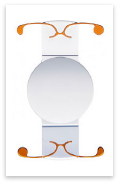Posted on: 07/19/17
Cataract Lenses, Cataract Surgery, IOL'sWhen it comes to cataract surgery, you have options for your lens implants.
 NearVision lens implants are intraocular lenses that are implanted inside the eyes of cataract surgery patients to replace their natural lens. Without these lenses, the patient has to wear eyeglasses or special contact lenses for the rest of their life. The other type of intraocular lenses are standard lens implants, which also serve the same purpose.
NearVision lens implants are intraocular lenses that are implanted inside the eyes of cataract surgery patients to replace their natural lens. Without these lenses, the patient has to wear eyeglasses or special contact lenses for the rest of their life. The other type of intraocular lenses are standard lens implants, which also serve the same purpose.
A cataract is a condition in which the natural lens of the eye becomes progressively clouded, resulting in blurred vision and ultimately blindness. It is the most common cause of loss of vision in people over 40 years of age and is the main cause of blindness in the world. When a cataract become too cloudy, the affected lens has to be removed and replaced with an intraocular lens. Cataract removal surgery is a safe and painless procedure that is performed using local anesthetics.
Cataract patients may or may not have to wear glasses depending on the type of intraocular lens they have received. Those who have received premium lens implants do not need to wear glasses while those who have received standard lens implants usually have to wear glasses.
Before intraocular lenses (IOLs) became available in the 1980s, cataract patients had no option but to wear special contact lenses or very thick eyeglasses. Today, you can choose from a wide variety of premium and standard lens implants. The right lens for you depends on factors like your lifestyle and specific needs.
NearVision versus Standard Lens Implants
- Standard lens implants: These implants are good for shortsighted patients without astigmatism. The patient has to wear glasses to read and to do near activities. In other words, these implants are good for distance vision only. One advantage they have is that they are covered by all insurance companies including Medicare.
- NearVision lens implants: These implants are good for both nearsighted and farsighted people, and those with astigmatism. Cutarelli Vision emphasizes the use of the Symfony and Crystal Lens NearVision implants. Most cataract patients with NearVision lens implants do not need glasses after surgery. Patients willingly pay out of pocket for this dramatic lifechanging technology.
Types of NearVision Lens Implants
There are several different types of FDA-approved NearVision lens implants available in the market, and astigmatism-only correction lenses. They include Toric IOLs, Accommodating IOLs, and Multifocal IOLs.
- Multifocal IOLs: These NearVision lens implants expand your range of vision by added magnification in different parts of the lens. They allow the patient to see clearly at all distances.
- Accommodating IOLs: These NearVision lens implants have both an aspheric design and flexible legs (called “haptics”) to expand the range of clear vision. They provide a better near vision than conventional mono-focal lenses.
Astigmatism Correction: If you have astigmatism, the surgeon can correct it around the time of cataract surgery by using incision placement and size, lens implant, and postoperative LASIK surgery (generally at 6 weeks). Astigmatism correction can profoundly improve the quality of your vision after cataract surgery.
If you have questions about which lens is best for your way of life, contact us.







